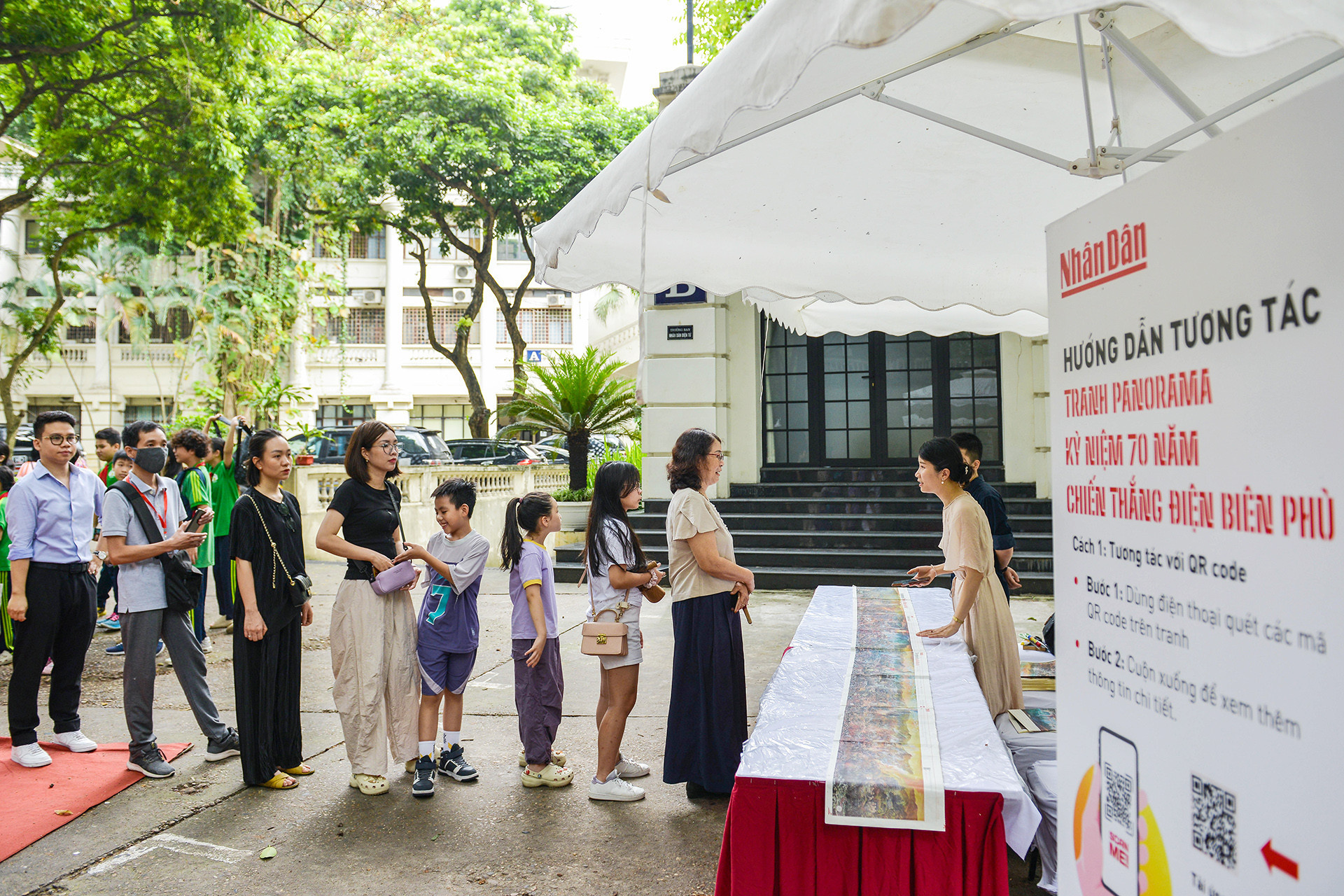“In recent years, we have seen many remarkable and commendable steps in some local Party press agencies. Newspapers such as Nghe An newspaper, Ha Tinh newspaper, recently Hai Duong newspaper and especially Dak Nong newspaper.”
Comrade Le Quoc Minh, member of the Party Central Committee, Editor-in-Chief of Nhan Dan Newspaper, Deputy Head of the Central Propaganda Department, Chairman of the Vietnam Journalists Association shared in an online discussion of VietNamNet Newspaper with the topic "Innovation and creativity in journalism in the digital age".

BOLDLY TRANSFORMING DIGITALLY WILL CREATE IMMEDIATE RESULTS
Could you tell us how strongly digital technology is affecting the field of journalism and media today?
For the field of journalism and media in the world, technology has been a long-standing companion. Over the past 20 years, we have seen the emergence of technology in journalism activities and technology is an indispensable part of journalism.
However, in Vietnam, this has not happened for a long time. For a long time, we have only stopped at using technology in a fairly simple way. Even when we have an electronic newspaper, an electronic information page, we still compare it to making a printed newspaper on an electronic platform.
However, it must be said that the Covid pandemic has acted as a catalyst for digital transformation and stronger application of technology in journalism in Vietnam, from newsroom activities (for example, online meetings) to the use of content production tools... all of which have been implemented more effectively by newsrooms.
However, if we call it true digital transformation and a true operating environment in the style of a digital newsroom, not many press agencies have achieved it. Currently, many newspapers are still mixing traditional methods with the use of some new tools.

At the National Press Forum held in March within the framework of the National Press Festival 2024, Minister of Information and Communications Nguyen Manh Hung delivered a speech emphasizing: “Digital innovation is the new driving force of journalism. Investing in digital technology, digital human resources, digital data and digital innovation will be an investment for the future of journalism.”
From your experience in press management, what do you think about this statement of the Minister?
Some Vietnamese press agencies have made certain progress. For example, Vietnam Television and Voice of Vietnam are quite early adopters of technology and digital human resource training.
If we look at how VTV 24 does it with some of their social media channels, we see that it is very professional and different from many other press agencies in simply posting content on fanpages, Youtube or other social media channels.
Vietnam News Agency, when I worked, in 2018 created a Chatbot and won first prize at the Asia-Pacific News Agency Association award. It can be said that for major press agencies, preparation and readiness for the digital economy and digital transformation have taken certain steps.
However, for most other press agencies, these steps are quite slow. We are concerned, especially with the wait-and-see attitude, wanting to wait and see how other press agencies do it? Are they successful or not? What model can be imitated instead of having to create a suitable model. From there, people hesitate, do not know where to start or always think that if they want to transform digitally, it means having to invest in expensive technology, huge finances... and along with that is the story of human resources not being properly prepared.
In many places, young reporters know how to use the management system, post news content, process a few images... But that's it.
However, in recent years, we have seen many remarkable and commendable steps in some local Party newspapers. Newspapers such as Nghe An newspaper, Ha Tinh newspaper, recently Hai Duong newspaper and especially Dak Nong newspaper. This is a Party newspaper with a fairly small staff, in a province that does not necessarily have good economic conditions, but when they converted to digital and applied new methods, currently, the number of visits to Dak Nong newspaper has reached the highest level in the Party newspaper system for many weeks.
That shows that if we boldly transform digitally, it is not only necessary for large press agencies with economic potential and a large number of staff. Small press agencies, if they boldly go in the right direction, have determination and the leaders transmit that enthusiasm to the entire editorial office, to each staff member, will create immediate results.
THE HUNTING WAVE FOR SPECIAL PUBLICATIONS
You just mentioned a very strong change in the press. I would like to mention the special publication commemorating the 70th anniversary of the Dien Bien Phu Victory, which created a “wave” of collecting among young people in Hanoi. Could you tell us more about this publication?
Commemorating the 70th anniversary of the Dien Bien Phu victory, we determined that this was a very big event. Normally, for such commemorative events, maybe a few weeks or at most a month in advance, some press agencies will build a website or a column, and then put in a lot of information in the form of text, images, etc.
The Dien Bien Phu victory anniversary has had many stories that we have exploited over the past 70 years.
If we continue to tell stories like this, it will no longer be as effective as it was when we only had print newspapers and radio and television. Now we have online newspapers and billions of social media channels. So it is not easy to attract users with traditional propaganda methods anymore.
We decided to do it differently. With the electronic version, we launched a website but followed the 56 days and nights of “digging mountains, sleeping in tunnels, raining, eating rice balls”, and it was like a diary for readers to follow every day, then look forward to the next day. In addition to reading information, they played games to test their knowledge. But that was just the beginning.

We also wanted to create a unique printed newspaper product. At first, we only thought of a special topic that could be 6-8 pages. But when making a book on innovation in journalism and media in 2023 to serve the National Press Festival, in the section on innovation for printed newspapers, we noticed that a German newspaper, in commemoration of the 50th anniversary of the Berlin TV Tower, printed a 2.35m newspaper page with an image of the Tower and descriptive and explanatory graphics...
We thought it was a pretty cool idea. We had seen the giant painting at the Dien Bien Phu Victory Museum, and thought about printing it in a newspaper. But if we just did that, it wouldn’t be special. We thought of making something called a timeline and attaching it to the websites we had prepared for users to interact with.
We combined "augmented reality" technology, code scanning, moving images... and created a 3m21 long painting - perhaps the longest in print journalism.
After finishing the printed picture, we thought of organizing an exhibition in the editorial office yard for everyone to see. We organized an exhibition in Hang Trong and one in Dien Bien Phu Museum. With an application installed on the phone, users can scan the Al images at the exhibition.
During the week of the exhibition, at least 30,000 people came to see the exhibition in Hanoi as well as Dien Bien Phu. There were all kinds of people from inside and outside the country, from students to armed forces, workers... There were even young couples who came to the exhibition and took wedding photos.
Even more special, when this supplement was spread on social networks, it created a fever among young people. People asked each other how to get the 7/5 newspaper, then went hunting, even buying and selling online. On the last 2 days of the exhibition, we decided to print 5,000 more copies to serve the readers' needs but it was still not enough.
Nearly 3 weeks later, the fever still hasn’t cooled down. We mobilized social funding and printed another 100,000 copies, distributed at the headquarters of Nhan Dan Newspaper in 63 provinces and cities.
For the first time, we witnessed hundreds of thousands of people lining up at the headquarters of Nhan Dan Newspaper to receive the painting and enthusiastically share it.
Although we target young people when applying new technology, there are also many older people who are very patient to download the application, to experience the so-called Augmented Reality. This is a breakthrough when a printed publication of a Party newspaper, which is considered very orthodox, is welcomed by society in general and Gen Z, enthusiastically shared, thereby helping the newspaper's brand spread strongly.
We also brought this product to the Saint Petersburg Book Fair and many Russian friends also enjoyed the experience.
So from the time the first publication was published until the reprint, how many copies were printed in total, sir?
In total, there were nearly 300,000 copies, but the reach on social networks was estimated at 20-33 million people. Many people scanned the code in many countries, not just Vietnam.
So, in your opinion, is the use of digital technology to help readers, especially young people, use print newspapers on digital platforms that focus highly on interactivity a factor that creates the phenomenon of Gen Z hunting and searching for special publications?
The combination of technology is the factor that leads to this success. Because no matter how beautiful a picture we print, how good the articles we write, the ability to attract general users, not to mention young people to print products today is increasingly difficult.
In fact, the world press as well as Vietnam have also experimented with interactions, but this investment is not stable and long-term. There are newspapers that experiment for a while and then stop, maybe because it is expensive or the process is quite complicated.

PRODUCT THINKING IS VERY IMPORTANT
From this reality, how do you share about the important role of innovation, especially focusing on interaction with readers in general journalism innovation?
Experts have pointed out that in today's modern era, product thinking is very important.
Most of our news agencies are caught up in the daily, hourly routine of reporting. Occasionally we make a little innovation to make it more interesting, but that is not enough.
In the current context of information overload, where it is not clear what is right or wrong, it is recommended that press agencies must continuously create new products to attract users.
There are many cases where our press data is very large. The problem here is how to package it.
For example, Nhan Dan Newspaper has invaluable assets. It is more than 1,200 articles written by President Ho over a long period of time. Now people do not remember that there were such articles or if they want to find them, they cannot.
So we packaged it into an electronic product. Readers can search easily. We also made a similar website with articles by the late General Secretary Nguyen Van Linh…
What Nhan Dan Newspaper has done recently can help change the mindset that the newspaper is only for party cells, party members, and the elderly.
In addition to print newspapers, Nhan Dan online newspaper has also undergone a strong transformation in the past 2 years when we switched to a new content management system and changed the way we work.
CREATIVITY HAS NO BORDER
We have a special printed publication of Nhan Dan Newspaper that has created a fever among young people; VnEconomy Magazine has developed Askonomy - a virtual assistant, specializing in answering economic information - or the Digital Gallery and Information Integration of Hanoi Television... and many other new creative ideas and models. So, is there any limit to the story of innovation and creativity in the field of journalism and media with both print and electronic newspapers, radio and television, sir?
Journalism is a creative form, always having to be ahead in many fields.
So innovation in journalism is something that has always been there. Today's environment and technology allow us to do many things that we could not do in the past.
It depends on the mindset of each person. Sometimes this creativity does not necessarily come from the highest level, but from the reporters and editors.
Overseas, there are major newspapers that are always leading in innovation. For example, they are not only traditional newspapers, they also create many types of unique content and products. They organize tours and their travel journalists will become tour guides.
They also sell IT services. Newspapers like the Washington Post, after creating their own unique content management system, sell it to other news organizations (about 400 news organizations worldwide).
A French newspaper has a very interesting idea: on a certain day of the year, they will create content entirely for children, by children under the guidance of the newspaper.
We thought this idea was so good that in the June 1 issue of our weekly newspaper, we devoted an entire section written by children on energy and global issues.
For a long time we have seen newspapers for children but most of them are written by adults. We cannot really understand what they think and want. From the interesting experiment above, we have groups of child reporters who are trained in a variety of ways, using tools proficiently...
Creativity has no borders.
VN (according to Vietnamnet)